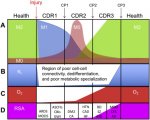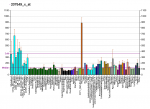[
Answers here! In-line with these questions re-posted + some bonus ones.]
Questions for Prusty (paper summarised
above):
(1) Does time frame of transfer effect suggest mechanism for patient's 1-2 day delayed PEM, crashes, etc? Naviaux's previously said [
2018] that "Mitochondria change their function rapidly under stress. Within minutes[...]". But you cultured the HHV-6 transactivated cells for 2 days and then the responder cells for 2 days in the transferred supernatant.
(a) Were these durations necessary for the phenotype transfer to work? (I.e. to accumulate or respond to the molecular factor.) Did you try shorter times to find a minimum?
(b) Or was the duration part of technical requirements of the analysis methods?
(2) Did this paper show cells in a CDR1 state? "M1" mitochondria and anti-viral protection are characteristic of Naviaux's CDR1 state. But he categorises ME/CFS as being a CDR3 disease [
2019, Fig.2]:

(a) Was he possibly mistaken about ME/CFS being CDR3 associated?
(b) Or are the majority of our cells stuck in CDR3 as a result of a smaller population of cells in CDR1 (e.g. with HHV-6 transactivation) preventing completion of the healing cycle?
(c) Or are the your observations not sufficient to draw conclusions on this because they are in cancer cells?
(d) Are the lab cancer cells naturally in a proliferative CDR2 state...?
(3) Was
Naviaux's contribution to the paper purely advice and/or interpretation (no lab work)?
(4) Which cells in patients are (or aren't) affected?:
(a) Are initial HHV-6A infections mostly limited to cells with higher CD46 expression (chart below)? And HHV-6B to cells with CD134, primarily CD4 T-Cells, etc?

(b) Was HHV-6A virus chosen, instead of 6B or 7, too be able to infect U2-OS and A549
(c) Could the extent of the initial (latent) infection determine the severity of ME/CFS, after the reactivation triggering event has passed?
(d) Or is infection and reactivation in specific locations more likely to be key? E.g. You've found infections all over the brain and brainstem [
YouTube].
(e) Could worsening of ME/CFS severity come from a spread of HHV-6 infection to more cells?
(5) Why do most people *not* get ME/CFS after acute infections, surgery, etc? If everyone has HHV-6 (and other viruses) latent in their bodies. (Some factors in 3, genetic and/or metabolic status?)
(6) How does HHV-6 transactivation become chronic in patients?
(a) The U2-OS and A549 cells are incapable of late stage viral replication. Is this also true for some cells in the human body (that can be infected)?
(b) Does the virus deliberately prevent itself from complete replication? What's the evolutionary advantage, if so? Is it related to blocking competing viruses from getting its host cell destroy by the immune system...?
(c) Is another mechanism needed for chronic HHV-6 activation? e.g. another infection, accumulation of toxic elements or other researcher's hypothesis (below)?
(7) Do you suspect interactions with any other proposed mechanisms? I.e. as them causing sustained HHV-6 transactivation, or vice versa? Specifically:
(8) Any hints of patient symptom phenotypes being separable by something you've measured...?:
(a) Detectable U14 (in 40% of sampled patients)?
(b) Inherited ciHHV-6?
(c) What about the never sick patients verses those who catch everything (or at least have repeatedly infection symptops).
(9) ATP production:
(a) Was this shown halved in the U2-OS cells, upon transactivation or with transfered supernatant. But a much more marginal reduction in the A549 cells (am I'm reading the paper right)?
(b) Does [
Fig.2D] show halved ATP production purely due to application of TSA? (If so, is that a big distorting factor on results?)

(c) Are the measured ATP concentrations indicate a matching scaling of flux (in production rate)?
(d) Would you expect to see a similar contrast in effect between different tissues within a patient? Or between patients? Or are these results not indicative at all, because they are cancer cells?
(e) Why is there a factor of 10 difference between ATP concentrations graphed in fig.2d verses fig.1c...? (An error?)
(10) Issue with the paper - Does the last sentence of your abstract seems to claim too much? You clearly showed strong similarities but no direct evidence of causation by HHV-6 in patients; it was an in vitro study. Is there unpublished work that bridges this gap?
(11) Serum factor...:
(a) Can you give us any more hints about what molecules you are currently honing in on, or the nature of the tests you've mentioned?
(b) Could the U14 protein be the factor? Seeing as it turns up in so many pathogens. But you only found it in 40% patient serum, so would that make it one of multiple factors? Or could it be pressent in all, but below your detection threshold?
(c) Have you been able to rule out any of the types of molecule you mentioned previously [
YouTube]? I.e. Mitochondrial metabolites, exosomes containing small non-coding RNAs or proteins, cellular RNA, antibodies, calcium flux...? And what about purinergic signalling (ATP, etc)?
(12) Personal relevance:
(a) Gradual onset - can this work on latent virus reactivation fit with (very) gradual onset of ME/CFS?
(b) Predisposing factors - could deleterious SNPs of SOD2 (or methylation enzymes, upregulated COMT, etc) make viral activation more likely? Or its effects more pronounced?
(c) Delayed sleep - Could the CDR state (or viral proteins) directly slow down the 24h clock gene expression pattern? Specifically, the
astrocytes in the SCN seem to be the body's master time keepers. Because circadian rhythm is so commonly delayed in the illness - probably more of a high level neurological issue (but it was my first symptom, worsening with very gradual onset).
(13) General curiosities:
(a) Can HHV-6 DNA show up sometimes in whole genome sequencing? I assume this is deliberately filtered out of the final data, even if its chromosomally integrated...?
(b) How close are we to having a working CRISPR system that could remove HHV-6 from humans (in vivo)? Would have to do this by providing immunity, blacklisting the key viral proteins, or something?
(c) Are there any exciting new laboratory technologies or equipment you expect to have access to in the near future?
[Answers
here! In-line with these questions re-posted + some bonus ones.]



